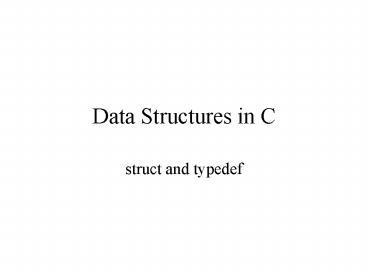Data Structures in C PowerPoint PPT Presentation
1 / 15
Title: Data Structures in C
1
Data Structures in C
- struct and typedef
2
struct
- Allows you to define a data structure composed of
pre-defined types. - struct may include other structures.
- structs may refer to themselves.
- struct defines a template for the data structure.
3
Using Structs
- Structs are generally globally defined. (Before
the main function.) - Syntax
- struct ltnamegt
- ltdatatypegt ltnamegt
- ltdatatypegt ltnamegt
4
Declaring Variables with Struct
- Variables follow normal naming rules.
- A struct is not recognized as a data type by
default. - Structs may be made into datatypes using the
typedef statement.
5
Declaring Variables with struct.
- struct record
- char name40
- int age
- void main(void)
- struct record rec
- struct record recref
- printf(Name s, Age d\n, rec.name, rec.age)
- printf(Names, Age d\n, recref-gtname,
recref-gtage)
6
typedef
- Adds a synonym for a data type.
- typedef struct
- char name40
- int age
- record
- Defines a synonym record for the structure.
- This allows you to define code like.
- record rec
- Which will allocate space for a record structure
named rec. - typedef may also be used to rename internal data
types.
7
typedef(cont.)
- To rename a datatype.
- typedef ltdatatypegt ltnewnamegt
- If color is represented by an integer value it
might be useful to define - typedef int color
8
File Handling
- All file handling is based on the FILE
datatype. - FILE is referred to a a file pointer.
- FILE associates the information in a file with
the data on disk. - To get a file pointer you must first open the
file. - The fopen function returns a FILE for use in
your program.
9
fopen()
- Syntax
- void main(void)
- FILE fp
- fp fopen( filename.ext, r)
- // Make sure to close your file after processing
- fclose(fp)
10
File handling
- FILE fopen( char ltnamegt,char mode)
- name is a string containing the name of the file
- mode is a string containing one of the following
- r - file is opened to read file must exist.
- w file is opened for writing file destroyed.
- r file is opened for read and write file
must exist - w file opened for read and write file
destroyed. - u file opened for update file may be read
writing occurs at the end of the file.
11
File handling continued.
- In addition to these modes a file may be opened
either as a binary or text file. - Text files may only contain ASCII data.
- Binary files contain images of the data.
- Files are opened as text by adding a t to the
open mode. - Files are opened as binary by adding a b to the
open mode.
12
File handling continued again
- Once the file is opened you need to read from it
or write to it. - We can use formatted input and output for this
purpose. - Standard output file stdout
- printf( char format, var, ,varn)
- Standard input file stdin
- scanf( char format, var, ,varn)
13
File handling yet again(so little hope for
advancement )
- Functions to deal with specific files.
- fscanf( FILE , char format, var, , varn)
- fprintf( FILE , char format, var, , varn)
14
File handling yet again(so little hope for
advancement )
- Another way to read and write files.
- fread() and fwrite()
- fread( void buffer,int size, int count, FILE
) - fwrite( void buffer, int size, int count, FILE
) - Use sizeof() to calculate size.
- Usually use 1 for the count unless you have a
specific need.
15
(No Transcript)

